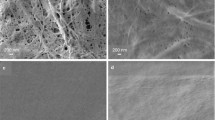Abstract
Composites made of inorganic filler particles and cellulose nanofibres can be applied as substrates for printed electronics. We have studied the structural properties of these substrates both experimentally and with particle-level modeling approach. Our model describes the skeleton structure formed by pigment particles of varied shapes and size distributions. Nanocellulose is assumed to fill voids of the structure. The model simulations predict quite well the relative changes in measured density, porosity and roughness for kaolin and precipitated calcium carbonate (PCC) pigments. Measured roughness turns out to be higher for kaolin than for PCC. Yet, the measured conductivity of printed lines on kaolin surface is higher than the conductivity on the PCC surface. The simulations reveal a more open surface pore structure for PCC than for kaolin, which leads to stronger absorption of the silver ink, and thus explains the differences in the measured conductivities.













Similar content being viewed by others
References
Bollström R, Määttänen A, Tobjörk D, Ihalainen P, Kaihovirta N, Österbacka R, Peltonen J, Toivakka M (2009) A multilayer coated fiber-based substrate suitable for printed functionality. Org Electron 10(5):1020–1023
de Berg M, van Kreveld M, Overmars M, Schwarzkopf O (2000) Computational geometry: algorithms and applications. Springer, Berlin
Frenkel D, Smit B (2002) Understanding molecular simulation: from algoritms to applications. Academic Press, San Diego
Hrehorova E, Pekarovicova A, Bliznyuk V, Fleming P (2007) Polymeric materials for printed electronics and their interactions with paper substrates. In: NIP23: international conference on digital printing technologies and digital fabrication, Anchorage, Alaska, pp 928–931
Kantola V, Kulovesi J, Lahti L, Lin R, Zavodchilikova M, Coatanéa E (2009) Printed electronics, now and future. In: Neuvo Y, Ylönen S (eds) Bit bang—Rays to the future, Helsinki University Print, pp 63–102
Kattumenu R, Rebros M, Joyce M, Fleming P, Neelgund G (2009) Effect of substrate properties on conductive traces printed with silver-based flexographic ink. Nordic Pulp Pap Res J 24(1):101–106
Kirkpatrick S, Gelatt C, Vecchi M (1983) Optimization by simulated annealing. Sci Agric 220(4598):671–680
Ong C, Gilbert E (2001) Fast versions of the Gilbert–Johnson–Keerthi distance algorithm: additional results and comparisons. IEEE Trans Robotics Autom 17(4):531–539
Penttilä A (2011) Light scattering in random media with wavelength-scale structures: astronomical and industrial applications. Doctoral thesis, University of Helsinki, Finland, http://urn.fi/URN:ISBN:978-952-10-7073-0
Perram J, Rasmussen J, Præstgaard E, Lebowitz J (1996) Ellipsoid contact potential: theory and relation to overlap potentials. Phys Rev E Stat Phys Plasmas Fluids 54:6565–6572
Persistence of Vision Pty Ltd (2004) (2011) Persistence of vision raytracer (version 3.6). Computer software, retrieved from http://www.povray.org/download/
Rew J (2003) Fortran 95 implementation of Quicksort algorithm. Computer algorithm, retrieved from http://www.fortran.com/qsort_c.f95
Torvinen K, Sievänen J, Hjelt T, Hellén E (2012) Smooth and flexible filler-nanocellulose composite structure for printed electronics applications. Cellul Chem Technol 19(3):821–829
van Delst P (2004) Fortran utilities. Computer algorithms, retrieved from http://www.ssec.wisc.edu/∼paulv/
Vidal D, Zou X, Uesaka T (2003a) Modelling of coating structure development using a Monte-Carlo deposition method. Part Charact 1: modelling methodology. TAPPI J 2(4):3–8
Vidal D, Zou X, Uesaka T (2003b) Modelling of coating structure development using a Monte-Carlo deposition method. Part Charact 2: validation and case study. TAPPI J 2(5):16–20
Vidal D, Zou X, Uesaka T (2004) Modelling coating structure development: Monte-Carlo deposition of particles with irregular shapes. Nordic Pulp Pap Res J 19(4):442–449
Volten H, Muñoz O, Hovenier J, de Haan J, Vassen W, van der Zande W, Waters L (2005) WWW scattering matrix database for small mineral particles at 441.6 and 632.8 nm. J Quant Spectrosc Radiat Transf 90(2):191–206
Acknowledgments
We would like to thank Dr. John Husband from Imerys Minerals Ltd for his help on estimating the shape and size distribution of Intramax 60 filler, as well as Imerys Minerals Ltd and Specialty Minerals for providing the materials. Asko Sneck and Heli Nykänen from VTT are acknowledged for SEM-images and printed conductor lines measurements. This work is part of the Efficient Networking towards Novel Products and Processes project, funded by the Forestcluster Ltd., Finland.
Author information
Authors and Affiliations
Corresponding author
Rights and permissions
About this article
Cite this article
Penttilä, A., Sievänen, J., Torvinen, K. et al. Filler-nanocellulose substrate for printed electronics: experiments and model approach to structure and conductivity. Cellulose 20, 1413–1424 (2013). https://doi.org/10.1007/s10570-013-9883-9
Received:
Accepted:
Published:
Issue Date:
DOI: https://doi.org/10.1007/s10570-013-9883-9




